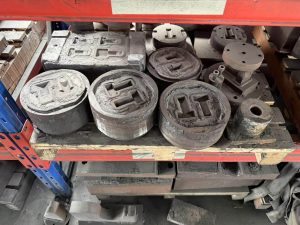Closed die forging
What is closed die forging
Closed die forging is also precision die forging. Closed die forging means that the forged metal blank can only flow inside the die, and then it is forged by the forging machine. No flash will be produced. Compared with open die forging, it will save a lot of raw materials and only produce a small amount of burrs (which can be cleaned up later). The forged parts are of higher precision and the forging efficiency is improved.

Closed Die Forging Process
First, cut the metal blank to the appropriate forging size.
Second, heat the metal blank. The purpose of heating is to soften the metal blank and facilitate forging.
Third, forging. Put the metal blank heated to the forging temperature into the lower die cavity. The upper die moves downward. The metal flows plastically in the closed die cavity. The metal fills the entire die cavity to form a forging consistent with the die cavity. The die is opened and the formed forging is taken out.
Fourth, deburring and machining. There will be burrs during closed die forging. At this time, the burrs need to be removed, and then sandblasting is performed. The next step is machining.

Process characteristics of closed die forging
First, cut the metal blank to the appropriate forging size.
Second, heat the metal blank. The purpose of heating is to soften the metal blank and facilitate forging.
Third, forging. Put the metal blank heated to the forging temperature into the lower die cavity. The upper die moves downward. The metal flows plastically in the closed die cavity. The metal fills the entire die cavity to form a forging consistent with the die cavity. The die is opened and the formed forging is taken out.
Fourth, deburring and machining. There will be burrs during closed die forging. At this time, the burrs need to be removed, and then sandblasting is performed. The next step is machining.
Process characteristics of closed die forging
1 The raw material utilization rate of closed die forging is very high, and no flash will be produced. The utilization rate will reach more than 99%, which can save forging costs for customers.
2 The closed die forging blanks are not only high in strength, but also very tough. Because the metal structure is very tight in the closed die, the forged parts have good performance.
3. Closed die forging can forge complex forgings, such as precision forgings for automobile engines, which can be achieved through closed die forging.

Process characteristics of closed die forging
1 The raw material utilization rate of closed die forging is very high, and no flash will be produced. The utilization rate will reach more than 99%, which can save forging costs for customers.
2 The closed die forging blanks are not only high in strength, but also very tough. Because the metal structure is very tight in the closed die, the forged parts have good performance.
3. Closed die forging can forge complex forgings, such as precision forgings for automobile engines, which can be achieved through closed die forging.

The difference between closed die forging and open die forging
The mold design is different. The closed die forging mold is closed, and metal can only be formed inside the mold cavity. When the open die forging is designed, one or both sides of the mold are open. During forging, the metal will flow to both sides and then form a cut edge.
2 The material utilization rate is not high. The closed die forging material utilization rate is very good, almost 100% utilization can be achieved. The open die forging utilization rate is low, which will produce cutting edges and increase costs.
3 Closed die forging is suitable for forgings with complex precision and stricter dimensional requirements. Open die forging is suitable for forgings with simple structures and simple sizes. Closed die forging is suitable for mass production, with an annual output of more than 50,000 forgings.
Factors Open die forging Closed die forging
Production batch Small to medium batch Large batch
Forging shape Simple to medium complex Complex shape
Equipment requirements Relatively small tonnage Requires larger tonnage equipment
Cost considerations Low die cost High die cost
Billboard requirements Volume control is not strict Must be accurately calculated
Closed Die Forging Materials
Closed die forging generally chooses carbon steel forging, stainless steel forging, and alloy steel forging. Typical grades include: Q235, 20 steel, AISI 1018, 45 steel, 40Cr, AISI 1045, 304 (0Cr18Ni9), 316 (0Cr17Ni12Mo2).
The key factors for selecting closed die forging materials are:
First, choose materials with good forgeability, such as carbon steel and stainless steel, such as 45 steel, which have particularly good forging performance. After forging, they can also be heat treated and machined.
Second, control costs. Some materials are expensive, such as 20CrNiMo materials, which are expensive and have high forging costs. You can choose alternative materials for forging.
Third, the material selection has good plasticity and is not prone to cracks during the forging process. For example, 42CR is a conventional forging material. It will not produce cracks during the forging process, and the overall metal material performance is excellent.
